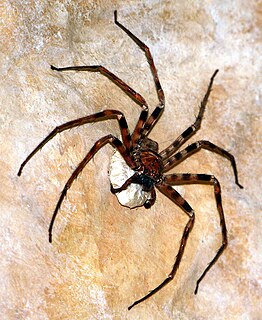
Huntsman spiders, members of the family Sparassidae, are known by this name because of their speed and mode of hunting. They are also called giant crab spiders because of their size and appearance. Larger species sometimes are referred to as wood spiders, because of their preference for woody places. In southern Africa the genus Palystes are known as rain spiders or lizard-eating spiders. Commonly they are confused with baboon spiders from the Mygalomorphae infraorder, which are not closely related.

Heteropoda venatoria is a species of spider in the family Sparassidae, the huntsman spiders. It is native to the tropical regions of the world, and it is present in some subtropical areas as an introduced species. Its common names include giant crab spider, or cane spider.

Heteropoda is a genus of spiders in the family Sparassidae, the huntsman spiders. They are mainly distributed in tropical Asia and Australia, while at least one species, H. venatoria, has a cosmopolitan distribution, and H. variegata occurs in the Mediterranean.

Yule Island is a small island in Central Province, Papua New Guinea. It is located 160 km NW from Port Moresby, on the south coast of Papua New Guinea.

The giant huntsman spider, found in Laos, is a species of huntsman spider (Sparassidae), a family of large, fast spiders that actively hunt down prey. It is considered the world's largest spider by leg span, which can reach up to 30 cm (1 ft).
Heteropoda dagmarae is a large species of spider in the family Sparassidae. This species is found in northern and central Laos. The spider is nocturnal and lives in forest. It hunts by ambushing its prey from shrubs, trees, and bamboo about two to four meters above the ground. It was not recorded as a new species until 2005.

Heteropoda davidbowie is a species of huntsman spider of the genus Heteropoda. It was described from the Cameron Highlands District in peninsular Malaysia and named in honour of singer David Bowie.

Heteropoda cervina, commonly called the brown huntsman, is a large species of spider in the family Sparassidae often found in leaf litter in central Queensland, Australia. The species was first described by Ludwig Carl Christian Koch in 1875 as Sarotes cervinus.
Brown huntsman spider may refer to:
Peter Jäger is a German arachnologist, and current Head of Arachnology at the Senckenberg Research Institute and Natural History Museum in Frankfurt, Germany.
Heteropoda eluta, is a species of spider of the genus Heteropoda. It is endemic to Sri Lanka.
Heteropoda kandiana is a species of spiders of the genus Heteropoda. It is native to India and Sri Lanka.
Heteropoda umbrata, is a species of spider of the genus Heteropoda. It is endemic to Sri Lanka.
Heteropoda squamacea is a species of huntsman spider found in China, described by J. F. Wang in 1990. The species has been erroneously synonymized with Heteropoda venatoria.
Yiinthi is a genus of South Pacific huntsman spiders that was first described by V. T. Davies in 1994. Y. lycodes was transferred from Heteropoda.
Dendryphantes subtilis is a jumping spider species in the genus Dendryphantes that lives in Kenya. The male was first described in 2014.
Heteropoda sumatrana is a species of spiders in the genus Heteropoda, family Sparassidae, found in Indonesia. It was first described by Thorell in 1890.
Arachnophagy describes a feeding behaviour that includes arachnids. Aside from non-human creatures, the term can also refer to the practice of eating arachnids among humans.





